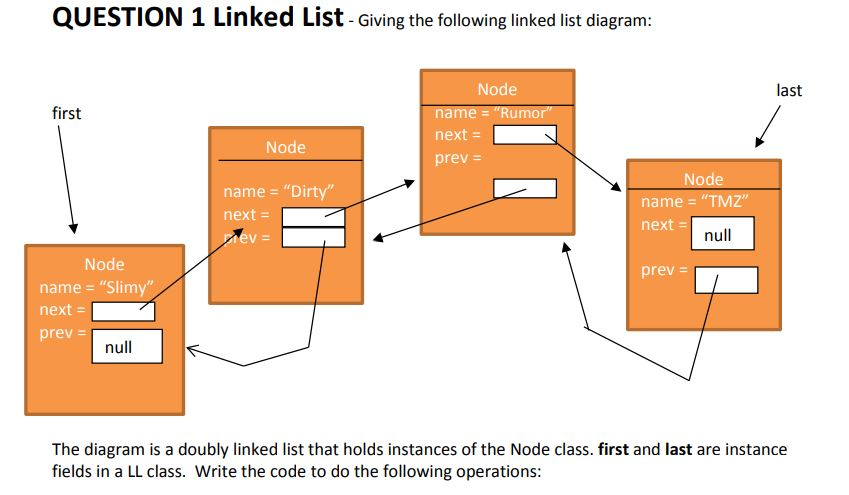Question
The first question is a Linked List question, A->E answsers(5) Second is Recursion A-C (3) A . Assume in this LL that you always remove
The first question is a Linked List question, A->E answsers(5) Second is Recursion A-C (3)

A. Assume in this LL that you always remove from the front of the list. In the method provided remove Slimy assume next and prev are public variables that you dont need a method to access, give the code to show the removal:
public void delete()
{
}
B.This time in the linked list insert a new node in the second position, leaving the first node the same, dont need to worry about an empty list. In the method provided below Insert the Node TEA after the Node Dirty (Because you already did step A, Slimy should be removed) assume next and prev are public variables that you dont need a method to access:
public void insert()
{
Node ref = new Node(TEA);
}
C. Now assume the delete End method below always removes from the end of the list In the method provided remove TMZ assume next and prev are public variables that you dont need a method to access, and the linked list diagram should be updated with the steps from questions A, and B above:
public void deleteEnd()
{
}
D. Assume in this linked list that now you need to add a new node at the end of the list. In the method provided below Insert the Node Donkey after the last Node in the list assume next and prev are public variables that you dont need a method to access the references:
public void insert()
{
Node ref = new Node(Donkey);
}
E. Redraw the list with all the updates (A->D) above. Use the graphic above as a reference on how to draw the list, show all the nodes, what all prev and next are referencing as well as first and last.
Recursion
Consider the following three functions defined recursively:
void mystery1(int n)
{
if (n == 1)
System.out.println(n);
else
{
System.out.println(n);
mystery1(n-1);
mystery1(n-1);
}
}
void mystery2(int n)
{
if (n == 1)
System.out.println(n);
else
{
mystery2(n-1);
System.out.println(n);
mystery2(n-1);
}
}
void mystery3(int n)
{
if (n == 1)
System.out.println(n);
else
{
mystery3(n-1);
mystery3(n-1);
System.out.println(n);
}
}
What is the output for the following (no errors, in same instance so no instance reference needed.....the method call works, the method works):
A.mystery1(4);
B.mystery2(4);
C.mystery3(4)
QUESTION 1 Linked List-Giving the following linked list diagram: Node last first name "Rumor" next = prev Node Node name-"Dirty" next name "TMZ next = null Node prev name = "Slim next = prev null The diagram is a doubly linked list that holds instances of the Node class. first and last are instance fields in a LL class. Write the code to do the following operationsStep by Step Solution
There are 3 Steps involved in it
Step: 1

Get Instant Access to Expert-Tailored Solutions
See step-by-step solutions with expert insights and AI powered tools for academic success
Step: 2

Step: 3

Ace Your Homework with AI
Get the answers you need in no time with our AI-driven, step-by-step assistance
Get Started


